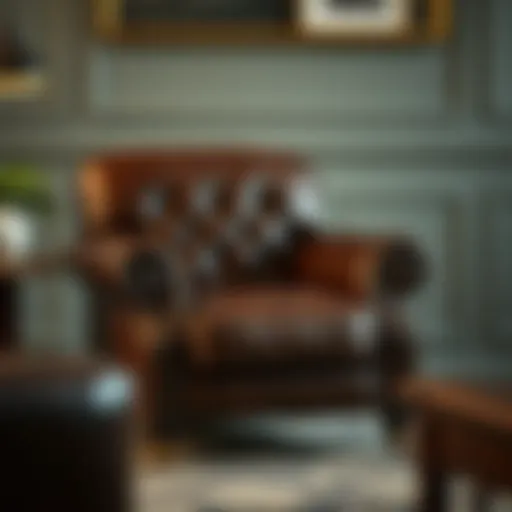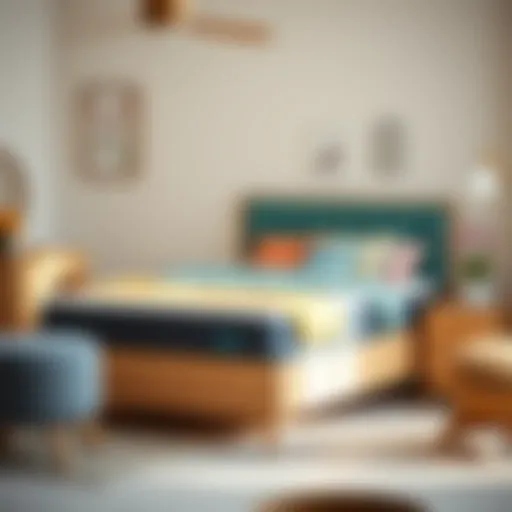Mastering Kitchen Cabinet Shelves: Design and Tips
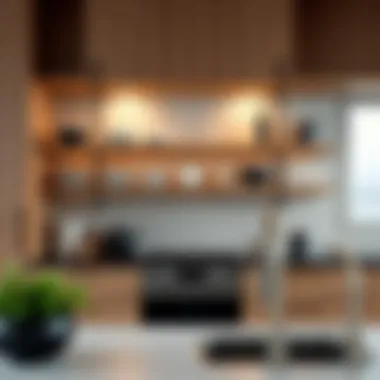

Intro
In the heart of every home, the kitchen often takes center stage, serving not just as a cooking area but as a gathering place for family and friends. A key element that contributes to the kitchen’s functionality and aesthetics is the cabinet shelving. Understanding kitchen cabinet shelves goes beyond simply picking a nice color or material; it involves making informed choices about design, functionality, and the best practices that can transform a cluttered space into a model of efficiency.
This guide dives into various aspects of kitchen cabinet shelves—breaking down types, materials, and innovative organization solutions that offer practicality while maintaining style. Homeowners, designers, and DIY enthusiasts will find a wealth of actionable insights here, poised to elevate their kitchen space.
A well-thought-out shelving system does more than just hold your dishes and appliances; it reflects your taste and supports your daily routines. Practical shelving effectively maximizes space, and clever organization techniques can reveal a world of possibilities in optimizing your kitchen for both functionality and aesthetic appeal.
As we explore this topic, we’ll discuss current design trends that influence cabinetry, materials that stand the test of time, and best practices that ensure each inch of your kitchen is as efficient as it is beautiful.
Design Trends
Current Trends in Kitchen Shelving Styles
Design trends in kitchen cabinetry evolve continuously, influenced by lifestyle changes, advances in technology, and aesthetic preferences that fluctuate over time. Recently, there has been a significant shift towards minimalism, where clean lines, open spaces, and uncluttered designs take precedence. For instance, floating shelves are gaining popularity, offering a modern twist that accentuates space while fulfilling storage needs.
In contrast, others may lean towards rustic charm, incorporating reclaimed wood or distressed finishes that evoke warmth and nostalgia. The incorporation of bold colors and unique textures also invigorates the traditional kitchen landscape, allowing for more personalized expressions of style.
When considering how to incorporate these trends into your space, think about the overall theme you want to achieve. A dark wood cabinet with brass fixtures conveys a classic, elegant look, while light, airy floating shelves might create a more contemporary feel. Ensure that the materials complement your existing décor, striking a balance that is visually appealing and cohesive.
Buying Guides
Choosing the Right Shelves for Different Needs
When selecting shelves, homeowners often overlook functional considerations in favor of aesthetics. It's crucial to consider the types of items that will inhabit your shelves. Will they store heavy cookware, delicate dishware, or both? Floating shelves may be ideal for lighter objects, while sturdier cabinets are a must for bulky items.
Here are some factors to consider when making your choice:
- Material: Plywood, solid wood, or metal finishes provide differing levels of durability.
- Weight Capacity: Choose shelves that can handle the weight of the items you plan to store.
- Ease of Access: High shelves might look great, but can be impractical for everyday use.
Assessing Quality and Value in Cabinetry
Investing in kitchen shelves is more than just a purchase; it’s a decision that can impact both utility and long-term satisfaction. Here are a few tips to assess quality:
- Joinery: Look for dovetail joints or mortise-and-tenon construction, which indicate durability.
- Finish: A well-applied finish protects against wear and tear, while also enhancing beauty.
- Warranty: Reputable manufacturers often offer warranties; this can be an excellent indicator of confidence in their products.
It’s not just about finding the cheapest option; instead, aim for a balance of quality and cost that aligns with the longevity you expect from your kitchen cabinetry.
"A well-structured kitchen cabinet system harmonizes both form and function, allowing for seamless storage that uplifts the cooking experience."
This understanding empowers you to craft a functional, aesthetically pleasing, and sustainable kitchen environment, perfectly aligned with your lifestyle.
The Role of Kitchen Cabinet Shelves
Kitchen cabinet shelves are not just mere platforms for items; they play a fundamental role in transforming a kitchen's usability and aesthetic. Understanding how these shelves fit into the larger picture of kitchen design and function is crucial for anyone looking to create an efficient and stylish space. The right shelving can turn even the smallest kitchen into an organized haven, providing storage solutions while enhancing your overall kitchen experience.
Understanding the Importance of Shelving
Shelves are the backbone of kitchen cabinets, allowing homeowners to make the most out of limited space. They provide areas to store food, kitchenware, appliances, and more, helping to reduce clutter on countertops. Think about it: a well-organized shelf can be the difference between a chaotic kitchen and a serene culinary environment. It’s about accessibility and aesthetics.
Some key aspects of shelving include:
- Space Utilization: Shelves maximize vertical space, making it easier to store items that might be cumbersome on countertops.
- Visibility: Open shelving, in particular, allows for quick access to frequently used items. Everything is easily seen and within reach.
- Customization: With various types of shelves, you can tailor storage solutions to meet specific needs or complement your kitchen design.
In essence, the importance of shelving extends beyond practicality; they help set the tone of your kitchen’s decor. From sleek glass shelves that lend a modern touch to rustic wooden options that exude warmth, the design of your shelving can define the entire atmosphere of your kitchen.
How Shelves Enhance Kitchen Functionality
The functionality of kitchen shelves is paramount. They serve multiple purposes, which can significantly enhance your cooking and gathering experience. Here’s a rundown of how effective shelving can elevate functionality in the kitchen:
- Organization: An organized shelf system reduces stress during cooking. Imagine a situation where you can easily see all of your spices or utensils – everything has its designated place, eliminating the need to dig and search.
- Ease of Cleanup: With items neatly stored on shelves, cleanup becomes a less daunting task. It’s far easier to wipe down shelves than to navigate around clutter on a countertop.
- Flexibility in Storage Options: Shelves can come in different styles—fixed, adjustable, or pull-out—which allows for versatile storage options. Adjustable shelves, for example, can accommodate various item sizes, from large pots to small spice jars.
- Open Shelving for Dual Use: Open shelves can serve as both storage and surface area to display decorative items or cookbooks. This blending of functionality and style creates a visually pleasing ambiance.
Types of Kitchen Cabinet Shelves
When it comes to kitchen storage, the type of shelving you choose could be the difference between a cluttered space and a well-organized haven. Each type of kitchen cabinet shelf serves a specific purpose and allows for different kinds of usage. Understanding these options gives homeowners, designers, and DIY enthusiasts the ability to tailor their kitchens not just for aesthetic appeal, but for maximum functionality.
Fixed Shelves
Fixed shelves are like the dependable workhorses of any kitchen cabinet system. As the name suggests, these shelves are anchored in place, providing a stable storage option. One major advantage here is their load-bearing capacity. Fixed shelves can handle heavier items, making them ideal for storing things like large pots, pans, and stacks of plates.
To install fixed shelves, you need to pay attention to height placement. If you put them too close together, you might find it hard to fit taller items. A rough rule of thumb is to leave at least 12 inches of vertical space for items like standing mixers or large cooking appliances.
Also, let's not forget aesthetics. With fixed shelving, it's easy to create a streamlined look, especially if the shelves are made from the same material as the cabinetry itself.
Adjustable Shelves
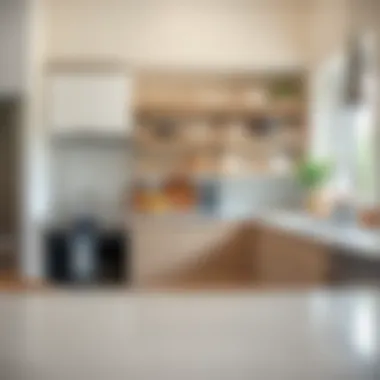

Adjustable shelves are the champions of versatility. With a simple rearrangement, you can customize the height between shelves to fit various items. This feature makes them a popular choice for those who frequently acquire new kitchen gadgets and appliances.
The key benefit is flexibility. You can start with a few basic dishes, and as your collection grows—like when you discover a penchant for exotic spices or suggestive cookbooks—you can adjust shelf heights to accommodate your ever-changing needs. Ideal for homeowners who enjoy experimenting in the kitchen, adjustable shelves offer functionality that can evolve over time.
However, while they are incredibly useful, it's essential to ensure that the materials used for adjustable shelving are robust enough to hold varying weights. If you're hauling out those heavy cookbooks or a collection of glass jars, make sure the support pins are sturdily installed.
Pull-Out Shelves
Ever thought about how easy it is to reach the back of a darker cabinet? Well, pull-out shelves are designed to tackle that ancient problem head-on. These shelves slide out on tracks, providing full visibility of everything on them. When you think about storing items like canned goods or baking trays, this type eliminates the awkward gymnastics often required to grab something shoved far in the back.
When installing pull-out shelves, focus on kitchen layout to maximize their benefits. The ease of access they offer truly transforms a kitchen into a more user-friendly space. Just be mindful of the depth and ensure your cabinet has enough room for the shelf to slide smoothly in and out.
Corner Shelves
Kitchens often have those tricky corner areas that seem to be just wasted space. Enter corner shelves, which are designed specifically to utilize those hard-to-reach nooks that would otherwise remain derelict. The L-shaped design or bi-fold panels are great solutions to make the most of those corners while enhancing storage capabilities.
These shelves can hold everything from spices to cookbooks, but their design can vary widely—from rotating mechanisms to more traditional shelf arrays. Proper organization here can improve overall kitchen flow. They also add a little visual charm to the space by breaking up linear designs.
Remember, when selecting corner shelves, consider accessibility and design—because aesthetics and function should go hand in hand.
In summary, understanding the various types of kitchen cabinet shelves can be a game changer. By recognizing their unique benefits, homeowners and designers can enhance both functionality and aesthetics in their kitchens.
Material Considerations for Kitchen Shelving
Choosing the right materials for kitchen cabinet shelves is crucial. The selection not only affects durability and functionality but also has a significant influence on the overall aesthetic of the kitchen space. Various materials come with their unique benefits and drawbacks. It is essential to weigh these factors carefully before making a decision that aligns with your needs and style.
Wooden Shelves: Pros and Cons
Wooden shelves have long been a staple in kitchen cabinetry. They offer a classic look and can blend seamlessly with many interior styles. The warmth of wood adds a touch of coziness to the often-cold surfaces found in kitchens. However, they are not without their disadvantages.
Pros:
- Aesthetic Appeal: Wood adds natural beauty. Options like oak, cherry, or maple can enhance a kitchen's charm.
- Customizability: Stains and paints allow wood shelves to match existing decor.
- Strength: Solid wood can bear significant weight, ideal for storing heavier items like pots and pans.
Cons:
- Maintenance: Wood requires regular sealing and polishing to prevent moisture damage and scratches.
- Warping: Changes in humidity can cause wood to warp over time, affecting its integrity.
- Cost: Quality hardwood can be pricey, making it less accessible for budget-conscious homeowners.
Metal Shelves: Durability vs. Aesthetics
When it comes to metal shelves, durability meets modern aesthetics. Stainless steel or wrought iron shelves can stand the test of time, making them an excellent choice for the bustling kitchen environment.
Pros:
- Durability: Metal does not warp, crack, or bow, even under considerable weight.
- Industrial Style: They offer a contemporary, often industrial, look that suits modern kitchens.
- Easy to Clean: Metal surfaces are generally easy to wipe down compared to porous materials.
Cons:
- Temperature Sensitivity: Metal can become hot or cold, posing a potential hazard when removing items.
- Rust Risk: If not properly treated, certain metals can rust, particularly in humid environments.
- Limited Design Options: Compared to wood, there are fewer design variations available.
Glass Shelves: Style and Functionality
Glass shelving delivers an innovative and stylish solution, often creating an illusion of space in smaller kitchens. They can showcase beautiful dishware or decor, making them both functional and decorative.
Pros:
- Aesthetic Versatility: Glass can fit into virtually any design scheme, from sleek modern to traditional.
- Light Reflection: Glass reflects light, brightening up dark areas.
- Easy Maintenance: Typically, glass is easy to clean with glass cleaner or a microfiber cloth.
Cons:
- Fragility: Glass is prone to shattering if not handled carefully.
- Weight Limits: Although strong, glass shelves may have weight limits that require consideration in storage.
- Cost: Quality glass can be more expensive than wood and metal alternatives.
Composite Materials: A Practical Approach
Composite materials, often a blend of wood and synthetic materials, present an opportunity for affordability without sacrificing style. These materials can imitate the appearance of high-end woods while providing economic benefits.
Pros:
- Cost-Effective: Composite materials generally come at a lower price point than solid wood.
- Moisture Resistance: Many composite options are engineered to resist moisture, reducing warping risks.
- Environmentally Friendly Options: Some composites are made from recycled materials, appealing to eco-conscious homeowners.
Cons:
- Less Durability: While water-resistant, composites are often not as strong as solid wood or metal.
- Limited Style Options: They may not offer the same range of aesthetics as genuine materials, appearing less authentic.
- Potential for Damage: Composite surfaces can chip or scratch more easily than other materials.
Choosing the correct shelving material requires careful consideration of your individual needs. It’s about finding that sweet spot where functionality meets style, all while keeping your budget in mind. Engaging with various materials can lead to a more personalized kitchen, tailored just for you.
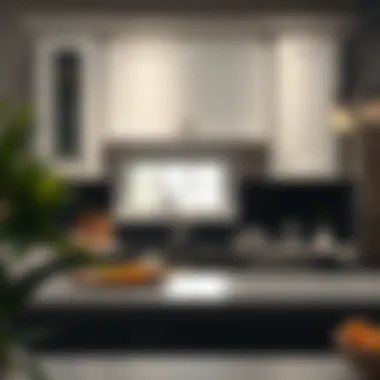

Designing Your Kitchen with Shelves in Mind
When it comes to crafting an efficient and aesthetically pleasing kitchen, the design of your shelves is central to the process. Shelving isn’t just about holding pots and pans; it plays a pivotal role in the overall layout and ambiance of your space. Let’s unpack some considerations that can transform ordinary shelving into a focal point of your kitchen.
Visual Balance and Proportion
The first thing to consider when designing your kitchen is how shelves can create balance. Imagine a well-organized kitchen where the eye flows naturally from one element to another. It’s crucial that the height and depth of your shelves are proportional to the rest of your kitchen elements. Too tall or too narrow can throw your space off-kilter.
Consider using shelves that mirror the shape of your cabinets. For instance, if you have tall cabinets, opt for longer shelves that extend horizontally. To achieve visual harmony:
- Group similar items together to prevent visual clutter.
- Use items of varying heights to create interest while still keeping it proportional.
- Don’t forget about the space between shelves; having them too close might make the kitchen feel cramped.
Color Coordination and Textures
Color plays a massive role in how we perceive space. Shelving can enhance or detract from your kitchen’s overall aesthetic based on its color and texture. If your kitchen has a neutral palette, adding a splash of color through uniquely painted shelves can liven things up. Conversely, if your kitchen is brimming with color already, a more subdued shelf color might balance things out.
Moreover, textures add depth to the design. Wooden shelves can bring warmth, while metal shelves might contribute an industrial feel. Here are some tips to consider:
- Match your shelving colors and textures to the materials present in your kitchen, like the cabinetry, countertops, or backsplash.
- Introduce a mix of materials; perhaps wooden shelves for aesthetics and metal ones for function.
Maximizing Vertical Space
In most kitchens, vertical space is often a forgotten asset that can be tapped into for a more open feel and added storage. By designing shelves that reach higher up the wall, you not only create more storage but also draw the eye upward, making the kitchen feel larger. Here’s how you can maximize vertical space effectively:
- Install shelves above cabinetry for items you rarely use, freeing up prime real estate below.
- Use taller cabinets that go all the way to the ceiling, allowing for pull-out shelves at the very top for infrequently used items.
- Consider floating shelves that create a sense of openness while capitalizing on height.
Incorporating Open Shelving
Open shelving is more than a trend; it’s a practical approach that offers style and function. This design choice invites creativity by letting you display your favorite dishes or decorative items, creating a personal touch in your kitchen. However, this method comes with its considerations:
- Think about accessibility: Items stored on open shelves should be easily reachable.
- Keep it organized: A cluttered open shelf can create chaos in an otherwise tidy kitchen. Group items in a visually appealing way and perhaps rotate them seasonally.
- Ensure strong brackets and supports: Open shelving often requires durable mounting systems to bear the weight of dishes and other items safely.
By taking the time to think through these elements when designing your kitchen shelves, you can create a kitchen space that’s functional, organized, and stunning. From visual balance that guides the eyes to maximizing every vertical inch, thoughtful shelf design integrates seamlessly into the cooking experience while elevating your home’s overall decor. As every chef and home cook knows, a well-designed kitchen is more than just a place to prepare meals; it’s the heartbeat of the home.
Optimizing Kitchen Storage Solutions
When it comes to getting the most out of your kitchen space, optimizing storage solutions is a critical part of the puzzle. It’s not just about having enough shelves; it’s about using those shelves wisely. Efficient use of kitchen cabinet shelves can transform a chaotic area into a well-ordered haven, enabling clearer access to items while enhancing the visual appeal of the kitchen. Through diligent planning and the use of clever organizing tools, one can maximize functionality while maintaining style.
Utilizing Shelf Dividers
Shelf dividers can be game changers when it comes to keeping your kitchen organized. These simple yet effective tools help create distinct sections for various items, enabling easy identification and access. If you have a tendency to let items pile up or become jumbled together, dividers offer a straightforward solution. You can categorize your cookware, dishware, or pantry items, turning a muddled mess into an organized array. Consider materials like wood or metal based on your kitchen’s theme. Dividers can be easily adjusted to accommodate different heights or sizes, making them versatile enough for any cabinet, such as those found from brands like IKEA or The Container Store.
- Benefits of Shelf Dividers:
- Enhanced visibility and accessibility of items.
- Reduced chances of items falling over or becoming damaged.
- Easier cleaning—simply remove and wipe down each section.
Incorporating Baskets and Containers
Baskets and containers play a pivotal role in optimizing kitchen storage solutions. These items not only offer an aesthetically pleasing way to store foodstuffs, utensils, or miscellaneous items, but they also help maintain order. By grouping similar items together, you can eliminate the frantic search for that elusive can of beans or odd utensil. For instance, deep baskets loaded with snacks can be tucked neatly away, while transparent containers allow you to see the contents at a glance.
- Considerations for Using Baskets and Containers:
- Select materials that align with your kitchen—woven baskets can add a rustic touch, while sleek plastic containers might suit a modern aesthetic.
- Labeling containers can help keep your pantry organized and make it easier to find what you need quickly.
The Role of Vertical Dividers
Vertical dividers serve a unique function in optimizing kitchen cabinets, particularly for larger items. They are particularly useful for storing cutting boards, trays, or even baking sheets. By utilizing vertical space effectively, you not only save horizontal space but also keep things much more accessible.
For instance, creating a dedicated space for baking sheets enables you to quickly grab what you need without pulling out a dozen other items first. This organizational strategy keeps your cooking experience smooth and enjoyable. Another aspect that adds to their utility is that they can be installed in almost any cabinet or shelf configuration, adapting to various kitchen designs.
"Proper organization is not only about style but about functionality, making your kitchen more enjoyable to work in."
In summary, optimizing kitchen storage solutions is essential for creating an efficient and attractive cooking environment. By incorporating shelf dividers, baskets and containers, and vertical dividers, you can enhance both accessibility and aesthetics within your cabinet space. A thoughtful approach to organization transforms not just your kitchen's physical appearance but also your cooking experience.
Maintenance of Kitchen Cabinet Shelves
Regular maintenance of kitchen cabinet shelves is vital for preserving both their functionality and aesthetics. A well-cared-for shelf not only enhances the look of your kitchen but also ensures longevity and optimal storage efficiency. After all, it’s easier to organize your pots and pans or stack those rustic plates when you’re not worried about worn-out or damaged shelving.
In this section, we will delve into two key considerations in the maintenance of kitchen cabinet shelves: cleaning recommendations and strategies to prevent damage and wear.
Cleaning Recommendations
Cleaning your kitchen cabinet shelves regularly is essential for maintaining a hygienic environment. Dust, grease, and food particles can accumulate, making not just your shelves but the overall kitchen feel neglected. Here are some practical cleaning suggestions:
- Use a Soft Cloth: A gentle cloth, preferably microfiber, eliminates dust without scratching surfaces.
- Gentle Cleaners: Avoid harsh chemicals, as they may cause discoloration or damage. Consider mixing a solution of warm water with a few drops of dish soap for an effective cleaner.
- Spot Treat Stains: For any stubborn stains, a mild baking soda paste (just baking soda and water) can do wonders without causing harm.
- Regular Schedule: Set a monthly reminder to clean your shelves. This habit ensures any buildup is dealt with before it becomes a bigger problem.
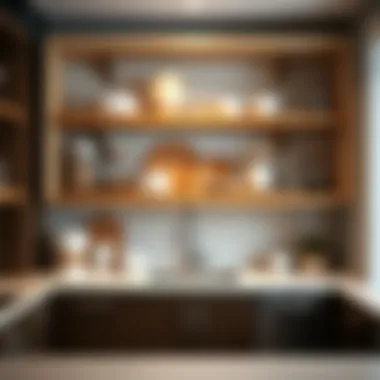

"A clean space often leads to clear thoughts. Regular maintenance helps keep your kitchen not just organized, but also a reflection of your personality."
Incorporating these cleaning habits not only sustains shelf integrity but also promotes a welcoming kitchen atmosphere, essential for any home cook or family meal gathering.
Preventing Damage and Wear
To extend the life of your kitchen cabinet shelves, preventive measures are crucial. Here are some strategies you should consider:
- Use Shelf Liners: Installing liners helps protect the shelves from scratches and spills. They can catch dirt and liquids, making cleanup a breeze.
- Avoid Overloading: Each shelf has its weight limit. Over stuffing shelves with heavy items can lead to sagging or breaking. Know the weight limits of your materials and distribute items evenly.
- Mind Your Utensils: When stacking dishes or kitchenware, be cautious not to scrape or bang them against the shelf. Using drawer organizers for small items can prevent accidents.
- Moisture Control: Humidity can warp wooden shelves. Ensure ventilation in your kitchen, and consider using moisture-absorbing products in enclosed cabinet spaces.
By applying these simple preventive steps, you not only safeguard the appearance of your shelves but also maintain their structural integrity over time. Investing a little time in maintenance reaps big rewards down the line.
Innovative Ideas for Kitchen Shelf Usage
Innovative ideas for kitchen shelf usage can transform ordinary spaces into organized, visually appealing areas. Such ideas don’t just happen overnight; they require a careful consideration of your personal style and storage needs. When done right, showcasing kitchen items can enhance your cooking space while also reflecting your unique taste. By balancing functionality with aesthetics, you can create a kitchen that serves its purpose without sacrificing charm. Let’s delve into two key areas: balancing display and storage, and incorporating lighting for effect.
Display vs. Storage: Finding a Balance
Finding the right balance between display and storage is crucial when designing your kitchen shelves. Items you use every day should be easily accessible while decorative pieces contribute to the kitchen’s ambiance. You’re walking a fine line; too many functional items on display might create clutter, while an excess of display pieces can limit actual usability.
- Practicality first: Use shelves for storing everyday essentials like spices, oils, or pots. This keeps them handy and reduces the time you spend searching.
- Showcase selectively: Choose a few elegant pieces, like beautifully designed dinnerware or artisanal collections, that reflect your personality. They should complement your kitchen's color scheme.
- Rotate items: Just like any good display at a museum, change out your decor periodically. This ensures your kitchen feels fresh and encourages creativity in the space.
Striking this balance often leads to a more fluid kitchen experience. When you open a cabinet, you should see items that inspire your culinary endeavors, not just ingredients that blend in.
Incorporating Lighting for Effect
The right lighting can elevate any kitchen shelving design. Shelves that might appear ordinary can become striking focal points with clever illumination. Natural light is a bonus, but artificial lighting techniques can draw attention to key pieces and create an inviting atmosphere.
- Under-shelf lighting: Installing LED strips under shelves is a clever way to highlight particular sections or items, making it easier to find things without straining your eyes.
- Spotlights for accent: Using spotlights to shine down on selected items can create a dramatic effect, especially for collections that deserve pride of place, like a vintage cookbook collection or handmade ceramics.
- Layered illumination: Combining ambient, task, and decorative lighting can help improve functionality while also setting a cozy mood. Think about dimmable lights to adapt the space for different occasions, from quiet evenings to lively gatherings.
Incorporating lighting isn’t merely about visibility; it’s also about creating an emotional connection with your kitchen. A well-lit shelf can elevate a simple bowl of fruit into a centerpiece that ties the whole kitchen together.
“A well-thought-out shelf can make a kitchen not just functional but also a joy to be in.”
Utilizing innovative ideas in kitchen shelf usage not only enhances organization but also adds a layer of character to your cooking space. By striking the right balance between display and storage, and effectively using lighting, any kitchen can be transformed into a functional and aesthetically pleasing environment.
Evaluating Suppliers and Brands for Kitchen Shelves
When it comes to kitchen renovations or upgrades, the choice of suppliers and brands for kitchen shelves is a substantial decision. A well-made shelf is not just a piece of furniture; it serves essential functions that cater to your kitchen's needs, aesthetic, and organization. Different suppliers offer varying qualities, and some may specialize in unique types of materials or styles which might suit your kitchen like a glove.
Assessing brands and their offerings ensures that you get value for your money and the longevity you desire. An informed decision here can save you headaches down the road and enhance your kitchen’s overall functionality.
Researching Material Quality
Understanding material quality is paramount. A shelf made from poor-quality material can lead to sagging, splintering, or even outright failure when loaded with kitchen essentials. When researching brands, one should consider several factors:
- Type of Material: Is the shelf constructed from solid wood, particle board, or metal? Each material has its own set of pros and cons. For instance, solid wood shelves offer sturdiness, while metal shelves can provide a sleek modern look.
- Weight Capacity: It's critical to know how much weight a shelf can handle. Brands usually provide this information, but you should seek out reviews or ask directly if you have doubts.
- Finish Quality: Pay attention to the finish on the shelves. A well-done finish can resist stains and moisture, keeping your shelves looking pristine over time.
Researching material quality is vital, as it impacts durability, appearance, and overall function.
Comparing Brand Offerings
When you're knee-deep in the process of selecting shelves, comparing brand offerings can help you hone in on what's best for your kitchen. Not all shelves are created equal; here's why brand comparison matters:
- Design Options: Some manufacturers may have exclusive styles or customizability. Figure out if you want open shelving, enclosed cabinets or something in between. Brands often have unique aesthetics that could match your kitchen’s theme.
- Price Point: It's no secret that prices can fluctuate wildly among brands. Ensure you compare not just the prices but also what you're getting for that price—are you looking at solid wood shelves vs. particle board?
- Warranty and Support: A brand that stands by its products typically offers better warranties. Look for brands that provide customer support and after-sales service. It can make a world of difference if you encounter issues after purchase.
- Customer Reviews: Don't underestimate the power of customer opinions. Reading reviews can shed light on real-world usage, durability, and any potential red flags.
In essence, evaluating suppliers and brands for kitchen shelves is not merely about the immediate aesthetic or price. It’s a detailed process of understanding offerings, which leads to making an informed investment in your kitchen’s future.
End: The Impact of Shelving on Kitchen Design
In the realm of kitchen design, shelving serves as more than just a platform for storing pots, pans, and an array of kitchen gadgets. It plays a vital role in enhancing the overall aesthetics and functionality of the kitchen space. The choices made in shelving can either uplift the essence of a kitchen or detract from its potential.
Understanding the impact of shelving on kitchen design is crucial for homeowners, designers, and DIYers alike. Let's delve into the specific elements, benefits, and considerations that underscore the importance of this topic.
Key Elements of Kitchen Shelving
- Accessibility: Thoughtfully placed shelves can significantly improve how efficiently kitchen items can be retrieved. If shelves are placed out of reach, no matter how beautiful they are, they become impractical.
- Design Consistency: The style and finish of shelves should harmonize with the rest of the kitchen. Mismatched elements can create a discordant look that might hurt the eye. For instance, rustic wooden shelves might clash with ultra-modern stainless finishes.
- Material Choice: The materials chosen for shelving not only influence durability but also the visual impact. Wood brings warmth, while metals can introduce a sleek elegance.
Benefits of Well-Designed Shelving
- Maximized Space: Properly designed shelves help leverage vertical space in kitchens that often come at a premium. Using the height of the walls can give rise to a sense of openness, making the kitchen appear larger.
- Organizational Efficiency: When shelves are arranged thoughtfully, it promotes a seamless workflow within the kitchen. It’s all about placing the right items in the right places; frequently used items should be accessible, while others can reside in higher or less visible cupboards.
- Showcasing Style: Open shelving offers a fantastic opportunity to express personal style. Items displayed on these shelves can be coordinated by color or theme, acting as a decorative aspect of the kitchen while still serving a functional purpose.
Considerations for Shelf Choices
- Weight Capacity: It’s important to assess the weight that each shelf can bear. This assessment could prevent accidents and damage to both the shelves and the items stored on them. Brands often provide specifications, but always consider the stability of the installation.
- Cleaning and Maintenance: Some materials require more upkeep than others. For example, glass shelves might need frequent cleaning to keep them looking pristine, while wooden shelves can be stripped or stained to maintain their beauty over time.
- Safety: Consider child-proofing in homes with little ones. Items that are too accessible can lead to potential hazards, making it crucial to evaluate the placement of high-value or dangerous kitchenware.
“Shelving is not merely about storage; it encapsulates an opportunity to elevate functionality and design simultaneously.”
In summation, the impact of shelving on kitchen design cannot be understated. It's all about strategic decisions that lead to improvements in both utility and style. From assessing the materials to thinking about the aesthetic flow of the kitchen, every choice matters. So, when you reevaluate your kitchen cabinet shelf choices, remember: balance and harmony should be at the forefront of your design vision.
This consideration can make a world of difference, resulting in a kitchen that not only looks great but works efficiently for years to come.
For further reading, you might explore resources such as Wikipedia or check out design boards on Pinterest, where you can find innovative shelving ideas that meld both form and function.





